- Published 6 Mar 2024
- Last Modified 6 Mar 2024
- 11 min
A Complete Guide to Jubilee Clips
Our jubilee clips guide explains the different types, sizes, materials, and manufacturers, before answering FAQs.

This guide to hose clips is designed to give you all the information you might need when choosing and buying Jubilee clamps online. By the end of the guide, you will know exactly what hose locks are, and which specifications they are categorised by (e.g. pressure ratings).
We will also highlight the various types, sizes, materials, and brands sold in the UK and answer some common FAQs about hose clamps and their proper use.
What is a Jubilee Clip?
While Jubilee clip is technically a brand name, the term is often used generically about other makes of hose clips, band clamps and related accessories. Original branded Jubilee clips are made by L Robinson & Company, but today you will find many quality manufacturers of durable, reliable hose clips online.
Jubilee clamps or hose locks are a common type of clip fastener, most often used to attach a length of tubing or hose pipe firmly onto a suitable fixture. This might be a spigot, tap, nipple, barb, or any other sort of outlet through which air or liquid can flow along the hose once clamped in place.
Hose clamps typically consist of a flat band of steel, nylon or brass, looped into a circle or band with some form of tightening mechanism on the outside. This is often designed as a sort of screw fitting and tends to include a worm gear for tightening (sometimes called a worm drive Jubilee clip).
How Do Hose Clamps Work?
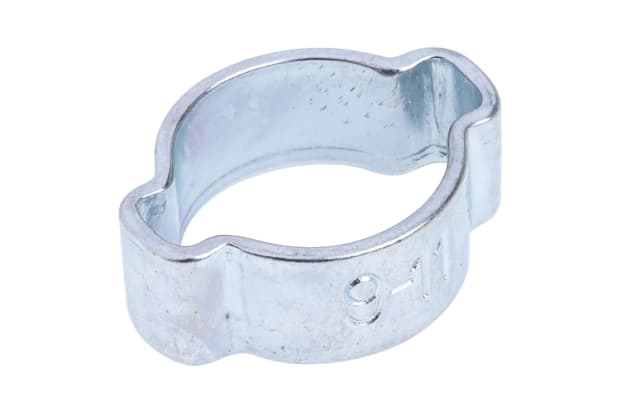
Hose clips usually work by being placed around the outside of the hose, at the point where it joins with and overlaps the outlet. The Jubilee clip can then be tightened down manually until it is pinched tight around the joint between the hose and spigot, minimising the risk of leaks or tube detachment under high pressure.
In most cases, they are designed to be tightened using a screwdriver or hex key once the clamp is in place around the hose. However, some hose locks feature alternative tightening methods, and might instead be labelled as spring clamps, wire clamps or ear clamps, depending on which method is used. Cheaper models such as O-clips do not have any screw mechanism and will require manual pinching or crimping to tighten.
They are simple to use - knowing how to install a hose clamp is usually just a case of reading the manufacturer’s instructions that come with the specific brand or product type you choose to buy. However, most types use similar mechanisms for installing and tightening, and it is usually easy to tell which type you are working with just by looking.
What are Hose Clips Used for?
Jubilee clamps, pipe clips or hose locks are normally used for securing hose or tubing around an outlet under pressure.
They also serve to moderate pressures in various applications and can therefore essentially operate as a type of compression or crimp fitting. This makes them incredibly useful in applications such as automotive engine assembly, along with a wide range of household and workplace settings.
Outside of mechanical, pressure or compression tasks, they are widely regarded and used as a highly versatile fastener that can be redeployed in a wide variety of roles. As the band design is so strong - especially when made from steel, nylon or other particularly hard-wearing materials - they are often used as a sort of heavy-duty cable tie.
For example, some types of hose clamp might be found securing other sorts of ducting, components and even wiring. Many variants of pipe clips (sometimes called pipe clamps) are effectively simplified hose locks and are made to be tightened using normal screws rather than featuring a built-in worm drive system.
You will frequently see them installed on all sorts of materials and components that are being held in place along walls and ceilings, or to other mechanisms and assemblies. Typical examples include holding signs, cables or fence poles, both indoors and outdoors.
Jubilee Clip Specification
Jubilee clamp specification will be found on the packaging or manufacturer guidelines, and normally covers a range of different ratings for each clip type and model. These generally include information such as capacity/opening sizes, clamping widths (the min-max extent of the clamping jaws themselves), and the maximum safe clamping or holding force.
Common standards associated with hose clamps, band clips and related fasteners include MIL-SPEC AA-52506 (for metal versions used to grip flexible hoses and ducts on a male fitting), and ISO 8177 (an international mark for verifying saddle clamp min/max gripping dimensions).
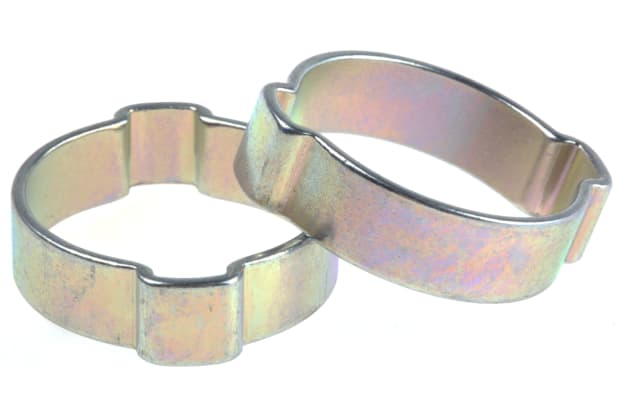
Jubilee Clip Pressure Rating
Jubilee clip pressure ratings refer to the maximum sustainable force that the tightened band can transmit and hold once tightened in place around a workpiece. It is always important not to over-tighten hose clamps, and many designs will include a blocking or locking feature beyond a certain point to prevent this.
Hose clip pressure ratings are dictated by a variety of mechanical factors, including the physical material the clamp is made from, its overall length and band diameter, and the type of tightening or fastening mechanism they use. Always check the individual specifications for a product before buying to ensure it meets the full requirements for your intended application's install location and torque demands.
Jubilee Clip Types
There are many different types of hose clips for sale online, from various manufacturers, including the original Jubilee clip design. They come in a variety of sizes, materials and tightening mechanisms, including heavy-duty Jubilee clips which tend to be the biggest and thickest of the available hose clamp designs.
Band clamps are easy to use and relatively cheap to buy, with smaller clips bought in bulk generally yielding the lowest fastener prices per unit. Over the following sections, we will give you a brief rundown of some of the most popular and versatile Jubilee clip types on the market.
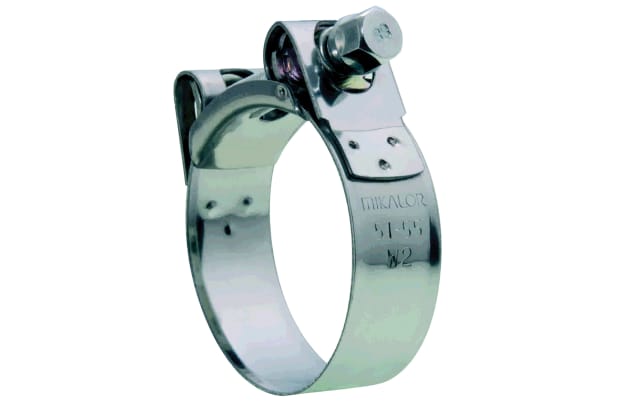
Bolt Drive Hose Clamps
Bolt drive hose clamps are also widely referred to as T-bolt clamps or head bolt clips. Usually made from stainless steel, they feature a small bolt mounted across the top of the band and secured at either end.
Tightening the bolt with a hex drive pulls in the hose clip from both directions, and keeps it gripped securely in place. For this reason, they are more commonly used in heavy-duty or industrial applications involving air or liquid media at high pressures.
Smaller versions for securing narrower ducting or hose runs are often called mini fuel clips, as they are especially common in automotive assembly, repair, and other related applications.
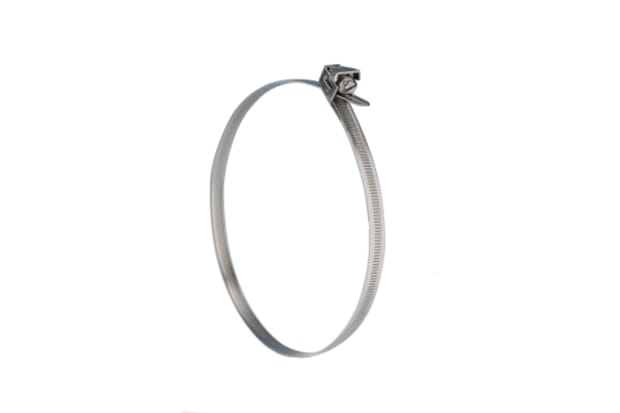
Quick Release Jubilee Clips
Quick-release Jubilee clips, also known as quick-release hose straps, are the most closely related band clamp type to a standard cable tie. Made from metal or nylon, they are essentially a beefed-up cable tie and are intended for use in situations where the strap needs to be fully opened before being placed around whatever they are securing.
Much like a zip tie, they are looped around the hose, ducting or other material while open. One end of the strap is then passed through a grip lock of some sort. They often feature a quick release swivel mechanism for easier removal. This type of band clip is often chosen for temporary use in applications such as sign fixing, cable retention or repairs.
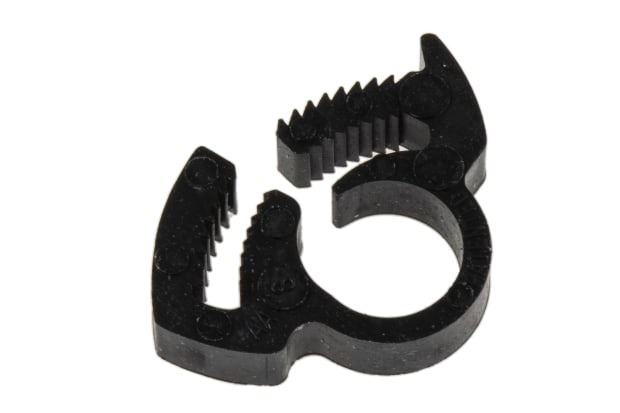
Snap Grip Hose Locks
A snap grip hose lock is also referred to as a Herbie grip. They are generally made from tough plastics such as nylon that have a degree of flex to them. Snap grip clamps feature ratcheting teeth designed to interlock firmly.
Thanks to the ratchet teeth, they can be tightened when squeezed in one direction but will resist pulling back in the reverse direction and loosening. In most cases, they are initially installed by hand then squeezed further with pliers to achieve the required tightness around cabling or pipework.
Being made of robust plastics, they are ideal for indoor and outdoor applications in industries such as marine, medical, food, automotive, agricultural, electrical, and white goods manufacturer and repair.
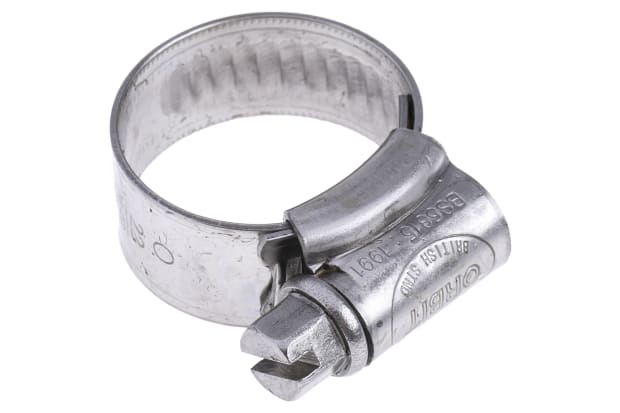
Worm Drive Hose Clips
Worm drive hose clips are the type of band clamp most people refer to when they say Jubilee clip. A Jubilee worm drive clip is easy to recognise as it features a slightly shorter and thicker worm drive (also known as a grub screw) mechanism on top of the band, compared to the slimmer profile T-bolt versions.
The Jubilee worm drive clip is the most common design for standard hose clamps and can be tightened using a slotted or hex driving tool. When tightened, they pull in and grip the circumference of the band from one side only, which means they are not quite as robust as bolt drive models. However, they are perfectly adequate for most standard applications and offer better sealing at lower torques than most nut and bolt style clamps.
Jubilee Clip Sizes
Jubilee clamps come in a wide range of sizes, including very small hose clips (sometimes called mini fuel clamps) right through to extra-large and heavy-duty Jubilee clips for use with industrial machinery and pipelines.
Common sizes include 10mm hose locks, 12-inch band clamps, and slim Jubilee clips for use on smaller gauges of tubing or cable runs. Jubilee clip sizes mentioned in manufacturer specifications will normally refer to a variety of measurements, including inside and outside diameter (both minimum and maximum), as well as the width of the band.
If you are looking to buy hose locks online, it is always important to know what sort of length and width you need to achieve a firm grip, as this will directly affect the amount of compression force the clamp can exert once installed.
What are Jubilee Clips Made of?
Stainless steel hose clips are probably the most common type found on sale in the UK and elsewhere, but it is also easy to find mild steel, brass Jubilee clips and nylon hose locks (especially the snap grip or Herbie clamp types). Zinc-coated steel is another popular choice, particularly for large or heavy-duty versions.
Plastic, stainless or galvanised versions are also common where the band clip is intended to be used outside, such as for marine Jubilee clips. It is possible to buy variously coloured Jubilee clips made from tough nylon, which can be useful for quick identification of different hoses and pipes.
The ideal hose clamp material for your needs will depend largely on how much pressure it will need to withstand once mounted to a hose or outlet, as well as the environmental conditions at the install location. Hose clip materials can also affect how easy they are to install and remove, so do bear this in mind when selecting a product for a specific use.
Jubilee Clip Manufacturers
At RS, we stock original Jubilee brand hose clamps as part of our high-quality product range. Other leading Jubilee clip manufacturers and suppliers that we work with include HI-GRIP, HI-TORQUE, JCS Hi-Torque, MIKALOR, Oetiker, and Unex.
We also offer our own in-house range of RS PRO band clamps, giving you the freedom to select the product best suited to your requirements.